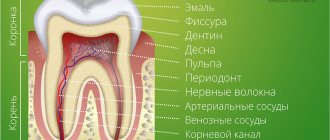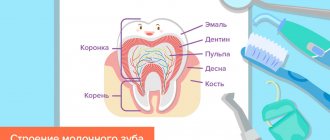Drawing a smiling sun
First we draw a circle, it will be the basis of the image. You can use a compass or trace an object (such as a coin).
Now let's designate the location of the spokes. They can be depicted in different ways: lines, stripes, in the form of trapezoids, triangles, in the form of drops, sunflower petals. The rays can be of different sizes, so the sun will look even more interesting. Choose the shape you like and draw. Erase the basting lines with an eraser.
To make the sun friendly and optimistic, we draw joyful eyes, a small nose, eyebrows and a smile. It can be depicted as a line with raised ends in a U shape in a semicircle. Or you can use the example in the article and look at the photo on how to draw a sun with a smile that reveals your teeth. Add freckles, a bow and handles to make the lamp even more beautiful. Draw all the contours again so that they become lighter and color the drawing.
Smile with uneven teeth or no teeth
Not everyone has been blessed by nature with beautiful, straight teeth. And some of them died during their lives. But expressing joyful emotions, everyone smiles. Even without teeth. Not everyone has the financial means to clean up the mess, or are you afraid of panicked dentists? Then a closed smile is suitable for you, without exposing your teeth.
If the natural color of your enamel is yellowish and you cannot cope, you need to visit a dentist and undergo a hardware whitening procedure. This is the only way to achieve the desired white color. And all the tricks with toothpaste remain just a successful PR move.
Practical advice
- Find the time, finances and courage to get your teeth in order. The most fervent laughter consists of opening your mouth and exposing your teeth. Otherwise, you will have to constantly cover yourself with your palm.
- Only a sincere smile can attract and bewitch. If you smile with bad intentions, it will look like a smile and others are unlikely to like it. Your eyes should laugh too, because they are called the mirror of the soul.
- Train your facial muscles. In front of the mirror, try to smile so that symmetry appears on your face. It may not work out the first time. When you achieve the desired result, look at the symmetrical smile for a couple of minutes. If you do this regularly, your facial expressions will become accustomed and your muscles will hear you more clearly.
- Take care of your lips. If you don't wear makeup, apply lipstick and give up the bad habit of constantly licking your lips.
%C2%A0
Dystopic and impacted wisdom teeth –
From the word “retention” - delay in eruption. Thus, an impacted wisdom tooth is the eighth tooth that cannot erupt for a long time. This may be due to lack of space in the dentition (for example, due to insufficient length of the lower jaw), or due to the complete or partially horizontal position of the tooth in the jaw. Impacted eighth teeth pose quite a danger to the bite, because... if there is insufficient space for eruption, they will push adjacent teeth, moving them towards the center. Accordingly, this will lead to crowding of the front teeth.
What impacted wisdom teeth look like -
In turn, a wisdom tooth is called dystopic when it has fully erupted, but not quite correctly. For example, it may be in an incorrect position, located not along the arch of the dentition, but, for example, closer to the cheek (or the tooth may have a strong buccal or lingual inclination). The decision to preserve such teeth is made by the dentist on an individual basis. For example, if, when closing the teeth, it injures the mucous membrane of the cheek, the patient is sent for removal.
What do dystopic wisdom teeth look like?
Funny tooth with brush and paste
It is very important to teach children hygiene, including oral hygiene. And it is equally important to do this in a form accessible to children. For example, in creativity. To do this, you can, for example, learn to draw human teeth. With a brush and ready-made paste.
The first step is to outline the shape. We draw in general, as in a school biology textbook.
Then we will draw a muzzle for the tooth. After all, this is quite a cartoon character telling children about the rules of dental care. So let's give him big eyes, slightly raised eyebrows and a joyful smile.
Now let's draw two small hands. In them, the tooth firmly holds the toothbrush and tube of toothpaste.
Let's color the drawing. The tooth will be white (except for pink gloves and a smile). Both the brush and the hose are blue. But let's make the bristles on the brush bright orange for contrast.
Our painting is now completely complete. You can hang this photo in the bathroom so that your child does not forget about oral hygiene in the morning. It also helps cope with childhood fear of the dentist.
Treatment of caries of primary teeth –
Treatment of caries in children under 3 years of age differs from treatment in older children. The choice of technique will primarily depend on 1) the age of the child and his behavior in the doctor’s chair, 2) the depth of the carious lesion, 3) as well as the behavior of the child’s parents. Typical inadequate demands of parents are “not to paint your teeth black”, “not to give an anesthetic injection”, “not to drill your teeth”, etc. All this makes it difficult to choose the optimal treatment method for a particular child.
1) Treatment of caries in children under 3 years of age –
In children of this age (depending on the depth of the carious process, as well as on behavior in the dentist’s chair), the following treatment methods can be used:
- remineralizing therapy,
- silvering (Fig. 11),
- deep fluoridation (Fig. 12),
- gentle filling of teeth (Fig. 13).
The method of tooth remineralization - remineralization of tooth enamel (saturation of it with calcium and phosphates) is carried out for the initial and superficial forms of caries of primary teeth. The course ranges from 5 to 10 procedures. As therapeutic agents, drugs such as, for example, calcium phosphate gel “GC Tooth Mousse” containing the complex “CPP-ACP” (casein-phospho-peptide-amorphous calcium phosphate) are used. An example of another product is “ROCS-mineral” based on calcium glycerophosphate and xylitol.
All these products can be used not only in the dentist’s office, but also at home. The main requirements are regular oral hygiene and a complete absence of plaque (plus the exclusion of the consumption of easily digestible carbohydrates, including sugary drinks). Treatment will not be effective if these requirements are not met. The drug “GC Tooth Mousse” will be more effective; it is easy to buy online and easy to use at home.
Deep fluoridation method (Fig. 12) - this method is also carried out in the presence of initial caries in the white spot stage, as well as in superficial caries. It is best to apply it in the second stage, i.e. immediately after the remineralization course. In total, a fluoridation course consists of 3-5 procedures, which consist of applying preparations based on sodium fluoride, tin fluoride, amino fluoride (optimally in the form of a varnish, which after application hardens on the enamel surface) to the surface of the tooth enamel.
The effectiveness of the fluoridation process greatly depends on the composition of the product used. It is important to choose an effective and at the same time safe concentration of fluoride for the child. You can read more about optimal medications at the link above. In addition, there is the drug “Enamel-sealing liquid Tiefenfluorid” (Germany), which is two-component and allows you to combine both remineralization and fluoridation at once.
Teeth silvering method (Fig. 11) - this method is used to treat initial caries in the white spot stage, superficial and medium caries. The silvering method is used only for the treatment of baby teeth, because... it causes areas of the tooth affected by caries to turn black. It is usually indicated in children no older than 3 years, because After 3-3.5 years of age, in most cases it is already possible to agree with the child on the traditional option of dental treatment (here, everything basically depends on the ability and desire of the dentist to find an approach to the child).
Of course, it is not entirely optimal to use it for the treatment of foci of demineralization in the form of white spots, as well as superficial caries, because Ideally, in these cases, it is advisable to conduct courses of remineralization and fluoridation. But with average caries (circular and planar forms), this method is not so bad, because In some children, it may be the only opportunity to survive until the physiological change of teeth, i.e. will allow you to do without their premature removal.
The optimal drug is Saforide (based on 38% silver diaminofluoride). According to the recommendations of the Russian Dental Association, silvering of teeth should be carried out not just once, but from 3 to 5 times. Only in this case is it possible to achieve stabilization of the process, but further maintenance repeated courses will be necessary, the period between which can be 1-3-6 months. The duration between repeated courses will depend on a number of factors, for example, the level of oral hygiene, the rate of caries progression, etc.
Gentle filling of teeth in children under 3 years of age - this method is carried out for superficial and medium caries. Don’t worry, filling teeth in children of this age is quite possible, and many dentists treat even 1.5-year-old children in this way. The most important thing here is the approach, and that the child is not scared from the very beginning. For example, it is very important not to cause any unpleasant sensations to the child during 1 visit, and therefore the child first only has his teeth brushed with polishing brushes and a tasty paste, and enamel strengthening agents are also applied to the teeth.
On the second visit, you can begin gentle filling. First, it is necessary to remove the sharp edges of the enamel and softened dentin. This can be done not only with a drill, but also with the help of scraping with hand tools specially designed for this. This is possible because the enamel and dentin in children of this age are much softer than in adults. It is also very important that in young children pain sensitivity in the teeth is reduced, and usually everything is painless.
There is another way to facilitate the removal of enamel and dentin affected by caries. This method involves first applying a special gel (for example, Carisolv, Switzerland), which softens tissues affected by caries and does not affect healthy enamel and dentin. After this, all that remains is to carry out very light scraping with hand tools. Nevertheless, it must be recognized that in some cases, high-quality filling can be carried out only after preparing the carious cavity with a drill, and in this case, only small carious cavities can be cured without anesthesia.
Important points that parents need to know before getting a filling -
- It is very important that the dentist has a “caries marker” drug, which helps the dentist determine whether he has completely removed the dentin affected by caries. In children of this age, this can be very difficult to determine. If the dentist leaves even a little bit of carious dentin, caries will occur under the filling, which will very quickly turn into pulpitis and acute pain. Those. If the doctor doesn’t have such a drug initially, I wouldn’t even sign up for treatment if I were you.
- Selection of material for filling - after removing all tissues affected by caries and appropriate antiseptic treatment, the actual filling begins. The second important point is the choice of filling material. Children of this age can and should have their teeth filled only with “glass ionomer cements” (GIC), for example, “Ketak-molar”, “Ionofil”, “Fuji IX”, “Cemion”, etc. In addition, even with average caries in children, a therapeutic pad made of calcium-containing material is always placed under such a filling.
2) Treatment of caries in children from 3 to 6 years old –
If your child has an initial form of caries (in the form of white chalky spots), then the treatment will be the same as for children under 3 years of age - remineralizing therapy, deep fluoridation, and in the worst case - silvering. We provided a link to these methods just above. For superficial, medium and deep caries in children of this age, it is optimal to use the technique of filling teeth with glass ionomer cements (GIC).
Before filling, carious tissues should preferably be drilled out with a drill, and only as a last resort can scraping of carious tissues with curettage spoons or smoothers be used. Under the glass ionomer filling (if the caries is medium or deep), a spacer made of calcium-containing material must also be placed.
Only if the child is emotionally unbalanced, is very afraid of the sound of the drill, in children who do not allow anesthesia or have a contraindication for it, in children with diseases of the central nervous system, it is preferable to use not a drill, but alternative methods of removing tissue affected by caries. It is also worth considering that if we are talking about a child’s very first visit to the dentist, then no invasive procedures should be performed during this visit (you should limit yourself to only polishing the teeth and applying fluoride varnish). This will allow the child to have a more positive attitude towards the dentist in the future.
How to find your angle?
First, figure out how wide your mouth can be. It all depends on the condition of your mouth and the health of your teeth. Smiling in front of the mirror, you can understand this moment. You should have a natural, relaxed smile that will highlight your best features. The mirror will help you with this like no other.
Notice what your gaze is doing now. Squinting your eyes slightly will complement your smile with naturalness and sincerity. This is an excellent solution for those who want to divert attention from imperfect teeth. The Duchenne smile is a heart condition that cannot be simulated. Be honest.
Wear colorful jewelry that may draw attention away from your lips. Unusual earrings with stones are perfect for this. Create an interesting hairstyle, wear a scarf or other fun accessory.
Ask a friend to take photos of you from different angles. Using the finished photographs, it will be easier for you to understand from which side and at what angle it is best to photograph in your case.
Be happy and bring happiness to others!
Teeth with a simple pencil - mastering basic drawing techniques
The pencil is a fundamental tool that any self-respecting artist should master. Then we work with the pencil technique and at the same time learn how to draw a tooth with a pencil.
First, let's draw the main lines: vertical axis, horizontal axis, general shape. All this is done to ensure that the lips are symmetrical.
Then we designate the height of the teeth themselves. It shouldn't be too big because some of them will be covered by the lips.
We draw the teeth on the lower jaw, and also mark the gums on the upper jaw.
Next we will also deal with the upper jaw.
In the final stage, all additional lines must be cleared and all main lines must be carefully placed.
That's all, we completely coped with the task. It's not that difficult, right?
Eruption of wisdom teeth -
The rudiments of all permanent teeth are formed in the prenatal period (i.e., during the intrauterine period of fetal development), but it happens completely differently with wisdom teeth.
The rudiments of the eighth teeth are formed in a child only at the age of 4-5 years. As for the process of eruption itself, most permanent teeth erupt between the ages of 6 and 12-13 years, with the only exception being the wisdom tooth. It usually begins its eruption no earlier than 18-21 years old, but this can still happen either at 14 or 40 years old. On the x-ray (Fig. 5) you can see a wisdom tooth in the process of erupting in a 20-year-old young man. The tooth has a fully formed crown, but the roots of the tooth are still in the process of formation and the x-ray shows how underdeveloped they are (24stoma.ru).
Thus:
- the crown of the eighth tooth completes its formation at approximately 12 years of age,
- The eruption of wisdom teeth usually begins no earlier than 18-21 years of age,
- The end of root formation occurs no earlier than 24 years.
On the radiograph (Fig. 6) you can see the wisdom teeth of the upper and lower jaws. The x-ray shows that the roots of the eighth teeth are already fully formed - therefore we can immediately say that this is a photograph of an adult. The lower wisdom tooth occupies a horizontal position, which generally excludes the possibility of its eruption. As for the upper wisdom tooth, in this case its crown rests against the tooth in front, and therefore complete eruption of the 8th tooth will probably occur only after the removal of the 7th tooth.
In Fig. 7 you can see the lower wisdom tooth in a state of eruption (view in the oral cavity). The tooth is at the stage of eruption when the chewing surface of the tooth crown is covered only by the mucous membrane, and one of the cusps of the tooth crown is already peeking out from under the mucous membrane. Very often, the mucous membrane over the wisdom tooth becomes inflamed, and this disease is called pericoronitis.
Smile from ear to ear - let's draw together
A smile is one of the sunniest and brightest phenomena. Of course, if it is caused by something good. Let's get into this fun mood and learn how to draw a smile with teeth.
First of all, draw the general contours of the lips. Since the mouth will be slightly open, draw the outline wider than when the mouth is closed.
Then we will separate the upper lip, lower lip and the space between them.
Then we will finalize the upper jaw. The teeth should not be the same size, otherwise the smile will resemble a fence.
Now let's repeat the same with the lower jaw. Only here the size of the teeth will be slightly smaller.
After that, let's color our drawing. Let's make the lips a rich red, the inside of the mouth pink, and the area around it a pale pink.
That's it, we completed the task.
Advice from psychologists
One more thing should be said about the miraculous power of a smile. He is able to cheer up even the person from whom he comes from. Psychologists advise immediately after waking up to smile at yourself - warmly, dreamily and gently stretch. It is also worth thinking that the coming day will be positive and successful. Only then will you be able to get out of bed and start your morning routine. It is very important that this seemingly insignificant ritual becomes everyday. When you start thinking positively, you will see how your life will soon change. Smile, laugh as often as possible, and not just in front of the camera.
We hope that after reading this article, you received the answer to the question of how to smile beautifully and will be able to shine with a radiant smile. And one last piece of advice. Look at the smiling face of the child, kind and sincere. Babies cannot smile under duress, which is why their smile is so real. Try it and you will follow their example. Laugh like you don't have a problem, enjoy life for whatever reason, and ignore the stereotype that Russians are people without a smile. You can change this opinion.
Structure of a wisdom tooth –
As we said above, the crown part of a wisdom tooth differs little from the crowns of other large molars (molars). In this case, it is more difficult to answer the question - how many roots does a wisdom tooth have? there may be two, three, four, or even five. On the other hand, there are eighth teeth with one large root. But if you take a closer look at such a root, you can usually see that it consists of several tightly fused roots at once (Fig. 3-4).
How is a wisdom tooth different from other teeth?
- firstly, wisdom teeth, as a rule, have strongly curved roots.
- secondly, curved roots mean that such teeth will have highly curved root canals and, accordingly, this makes them difficult when filling is necessary (for pulpitis and periodontitis).
What does a wisdom tooth look like: photo
In the photo, notice that some roots curl into a boot shape or several roots spread widely in different directions. This shape and position of the roots makes wisdom teeth extremely unpleasant for dental surgeons, because the curved roots often break off when the tooth is extracted, and then they have to be literally “plucked out” from the bone tissue. Read and see our article about how they are removed: → “Removal of wisdom teeth”
Functions of a smile
A person’s smile originates in the brain, in its subcortical region (limbic system). By definition, a smile is a reaction to an external stimulus. If you like something, you get positive emotions. If not, then negative.
Each emotion triggers different biochemical processes in the brain. They cause visible changes in the body. A clear example is expressive reactions. This is an external expression of emotions, proof that a person has some experiences, whether they are good or bad.
A smile in psychology is also considered an expression of emotions. If the face of your interlocutor does not express anything, of course, you will treat him with some uncertainty. Even a slight facial expression and a slight smile will change the situation for the better and can evoke love. It is not true?
A smile has other functions.
Communicative
In psychology, smiling is considered one of the ways of non-verbal communication. One of his responsibilities is to tell others what emotions a person is experiencing right now. And that is not all:
- Anyone who smiles automatically inspires confidence in others and instills in them a sense of security.
- Smiling and laughter are contagious. Therefore, by smiling, you can set your interlocutor in a positive mood. Often a smile appears on a person’s face even when viewing photographs of smiling people.
- Using this method of conveying emotions, you can easily express everything you feel right now. We are talking not only about positive emotions, but also about sympathy, apology, contempt, etc.
- A smile tells you what kind of person you are in front of you. It can be used to judge sincerity, good character, and aggression.
In addition, a smile is a corporate communication tool. Its absence can greatly interfere with communication.










